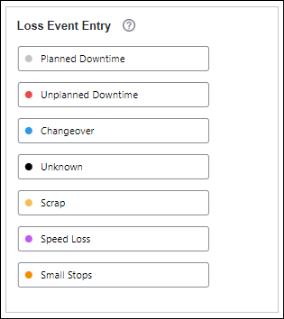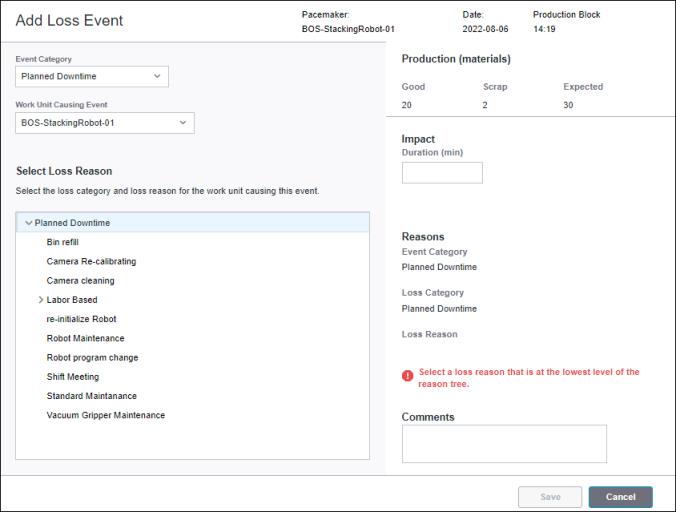Entering Loss Events for the Current Production Block
During production you can encounter a situation that results in lost production time. There may be unplanned situations, such as a power outage, planned situations, such as a scheduled lunch break or training session, or other expected time loss situations, such as the changeover time required to produce a different material. You may also determine that some produced material does not meet quality standards and must be scrapped. All of these situations are logged in the Production Dashboard as loss events.
Loss events can be logged against the current production block from the Loss Event Entry pane on the Production Dashboard.

Loss events for completed production blocks are entered during time loss accounting. |
Loss events are always logged against the pacemaker for the selected work center, but can be caused by another work unit that is upstream or downstream from the pacemaker in the work center. Each loss event includes the following:
• The event category, which is the loss category for the event on the pacemaker.
• The work unit that caused the event, whether that is the pacemaker itself or another work unit in the work center.
• The loss category and loss reason for the work unit that caused the event.
• The impact of the event, which is determined by the event category. The impact for scrap events is a quantity. The impact for all other loss events is a duration in minutes.
• An optional comment.
For example:
• Event Category=Unplanned Downtime
• Work Unit Causing Event=Name of the upstream work unit
• Impact=10 minutes
• Loss Category=Scrap
• Loss Reason =Imprecise cut edge
This loss event represents 10 minutes of unplanned downtime on the pacemaker resulting from material from an upstream work unit being scrapped due to an imprecise cut edge.
Entering a Loss Event
To enter a loss event, complete the following steps:
1. In the Loss Event Entry pane on the Production Dashboard, select the appropriate loss category: Planned Downtime, Unplanned Downtime, Changeover, Scrap, Speed Loss, Small Stops, or Unknown.
The Add Loss Event window opens, identifying the pacemaker, today’s date, and the start time for the current production block. The Production (materials) pane at the top right displays the current count of good material produced and the count of scrapped material for the production block. The expected production count for the production block is also displayed, which is calculated as the length of the current production block divided by the ideal cycle time for the material.

2. For Event Category, select the loss category for the event on the pacemaker. By default, this field displays the loss category that you clicked on the Loss Event Entry pane. You can change this value to another loss category if needed.
Only Scrap events can be manually added while an automated event is open. |
3. For Work Unit Causing Event, select the work unit which caused the loss to occur on your pacemaker. By default, the pacemaker for the work center is selected. If the reason for the loss event occurred on a work unit that is upstream or downstream from the pacemaker, you can select that work unit instead.
4. Under Select Loss Reason, navigate to and select the loss reason for the work unit which caused the event. If the pacemaker is selected as the Work Unit Causing Event, you can only select reasons from the loss category matching the selected Event Category. If a work unit other than the pacemaker is selected as the Work Unit Causing Event, you can select any loss reason that is valid for the selected work unit, from any loss category.
5. For Impact, enter the duration or quantity, based on the Event Category:
◦ For event categories other than Scrap, enter the number of minutes lost in the Duration (min) field. The Duration (min) value can be up to 13 digits, must be within the total duration of the production block, and must be an integer.
◦ For the Scrap event category, enter the number of scrapped units in the Quantity field. The Quantity value can include decimals, but can contain no more than 13 digits.
The Reallocate from Good checkbox determines whether the quantity being scrapped is removed from the Good count. To determine when to select the checkbox, consider whether the quantity that is being scrapped has already been logged as Good.
▪ If the quantity that is being scrapped has already been logged as Good, select the Reallocate from Good checkbox. When the checkbox is selected, the Scrap count increases and the Good count decreases. Production time for any count that is reallocated from the Good count is reallocated from effective production time to scrap loss time. When the checkbox is selected, the Quantity value cannot exceed the Good count for the production block.
▪ If the quantity that is being scrapped has not yet been logged as Good, do not select the Reallocate from Good checkbox. When the checkbox is not selected, the Scrap count increases and the Good count remains the same.
6. Under Reasons, the Event Category, Loss Category, and Loss Reason fields are populated based on the selections made in steps 2 through 4. If the selected loss reason is not at the lowest level of the reason tree, an alert shows below the Loss Reason field. You can save the loss event with this alert present, but your data will not be complete for the Pareto and trend charts in Performance Analysis.
7. Enter an optional comment in the Comments field, up to 2000 characters.
8. Click Save to add the loss event and return to the Production Dashboard. The event now appears in the event log.